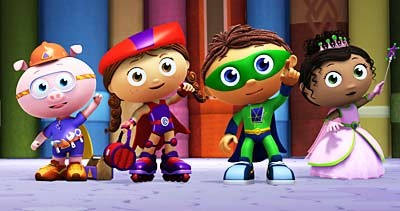 Super Why Characters
Super Why Characters
As a parent navigating the vast landscape of children’s television, finding shows that are both educational and engaging can feel like a Herculean task. Among the numerous options vying for our children’s attention, “Super Why,” featuring the character Whyatt, often emerges as a contender due to its literacy-focused premise. However, beneath the veneer of educational content lies a series of perplexing choices and questionable messages that might leave parents scratching their heads and questioning its suitability. This review delves into the intricacies of “Super Why,” particularly focusing on the central character, Whyatt, and the show’s overall effectiveness in delivering its intended educational value.
The Confounding Character of Whyatt
From the outset, one of the most jarring aspects of the show is the main character himself: Whyatt. Even the spelling of his name, “Whyatt,” feels like a bizarre oversight for a program purportedly centered around literacy and phonics. This immediately sets a strange precedent, hinting at a lack of attention to detail that permeates other areas of the show. Beyond the name, Whyatt’s personality traits quickly become grating. He is portrayed as an overly dramatic child, prone to declaring even the smallest inconveniences as “SUPER BIG PROBLEMS!” This tendency to exaggerate trivial matters not only undermines genuine problem-solving skills but also models an undesirable behavior for young viewers.
Consider the episodes where Whyatt and his “Super Reader” friends convene to address issues that are blatantly simple. A rock in a shoe, a leaf on the path – these are hardly situations requiring a team of superheroes and a journey into the world of books. Yet, Whyatt treats each of these minor hiccups as if they were crises of epic proportions, demanding the spotlight and turning everyday occurrences into elaborate productions. Furthermore, Whyatt’s intelligence is often questionable. In one particularly baffling episode, the solution to a character’s anger was simply to ask them why they were upset – a conclusion reached only after a convoluted and unnecessary quest. This lack of common sense in the central character makes it difficult for parents to view Whyatt as a positive role model for their children.
The Baffling Logic of the “Super Why” Universe
The show’s premise itself is riddled with inconsistencies and illogical elements. “Super Why” begins in a seemingly normal library, populated by ordinary people. Suddenly, Whyatt, a miniature character, emerges and beckons viewers into his world hidden within the books. The need for this separate, miniature world and its connection to the real world remains unclear and feels like an unnecessary layer of complexity. The transition into the “book club” and the transformation into superheroes are equally perplexing. Whyatt and his friends – Pig, Red Riding Hood (the “vegetable-obsessed one”), and Princess Pea (the “slutty one,” as the original reviewer crassly noted) – supposedly gain “powers” through transformation. However, these transformations largely consist of costume changes. The pig remains a pig, and the core identities of the characters are unaltered, making the concept of “super powers” feel superficial and underdeveloped.
The process of problem-solving in “Super Why” is equally convoluted. The Super Readers use a “SUPER DUPER… COMPUTER!” – a phrase punctuated by dramatic pauses in every instance, adding an unnecessary layer of theatricality. They embark on missions into books to find “super letters,” which are then fed into the computer to decipher clues. This sequence of events feels disjointed and lacks a cohesive, logical flow. The show attempts to blend literacy concepts with superhero tropes and fairy tale narratives, but the result is a confusing mishmash that struggles to create a unified and sensible experience for young viewers. Even the mode of transport into books – flying rockets that appear sporadically and without explanation – adds to the overall sense of randomness and lack of coherent world-building.
The Problematic Message of Rewriting Stories
Perhaps the most unsettling aspect of “Super Why” is its approach to storytelling and problem-solving within the books. Whyatt’s primary “power” is the ability to read and, more disturbingly, to change the words within the stories themselves. This concept presents a problematic message, suggesting that altering narratives to fit one’s immediate needs is an acceptable form of problem resolution. When faced with a conflict in a fairy tale, Whyatt doesn’t encourage critical thinking or alternative interpretations; instead, he resorts to censorship, rewriting elements of classic stories to achieve a convenient outcome. For instance, changing “eaten” to a more palatable verb in the Little Red Riding Hood story, simply to avoid an unpleasant plot point, fundamentally misunderstands the value of original narratives and the lessons they impart, even when those lessons are challenging or complex.
This “power of censorship” is used to solve trivial problems, like Whyatt’s rock-in-shoe scenario, by manipulating classic tales. The message sent is that rewriting established narratives is a valid way to overcome personal inconveniences. This is not only a misrepresentation of how stories function but also a potentially harmful lesson for children about respecting original works and engaging with narratives in their intended forms. The show concludes with a celebratory song about the Super Readers “saving the day,” but the nature of their “saving” often involves distorting established stories to resolve superficial issues, leaving a questionable impression on young, impressionable minds.
Conclusion: Why “Super Why” Misses the Mark
While “Super Why” aims to promote literacy skills in young children, its execution is marred by a series of significant flaws. The irritating personality of Whyatt, the illogical plotlines, and the disturbing message of rewriting stories to suit one’s needs all contribute to a show that ultimately falls short of its educational potential. Parents seeking genuinely educational and thoughtfully constructed children’s programming might want to explore alternatives that offer clearer messaging, more relatable characters, and a more respectful approach to storytelling. “Super Why,” despite its good intentions, unfortunately, becomes a case study in how not to create effective and enriching children’s television.

